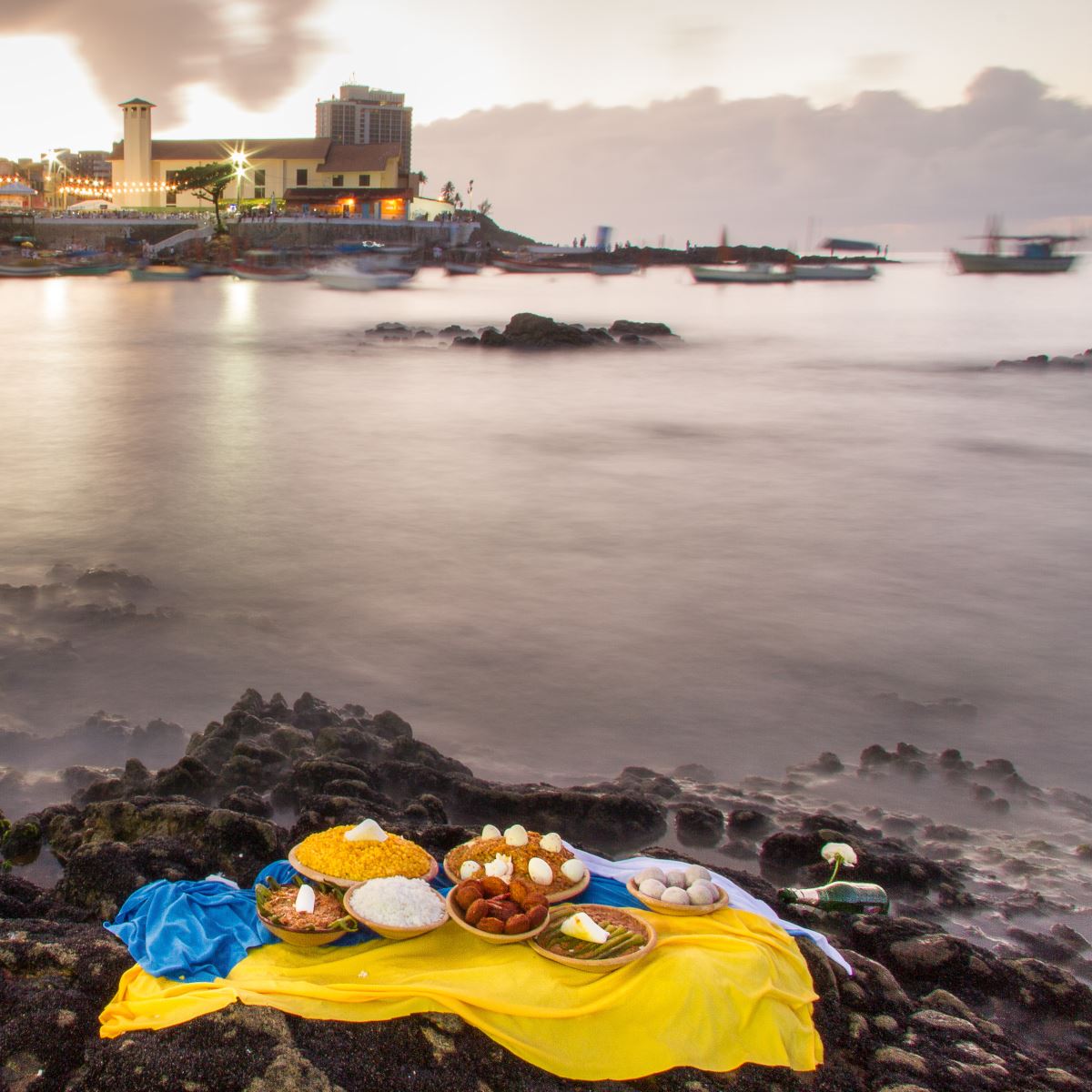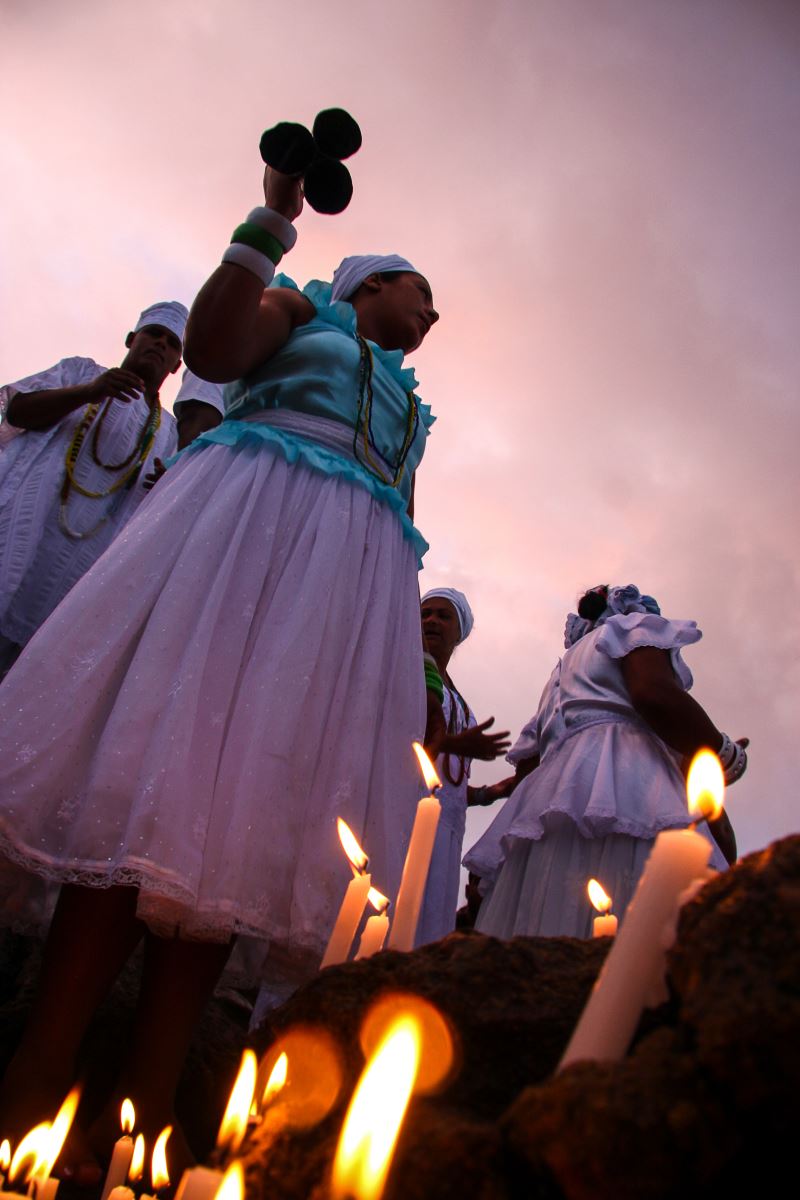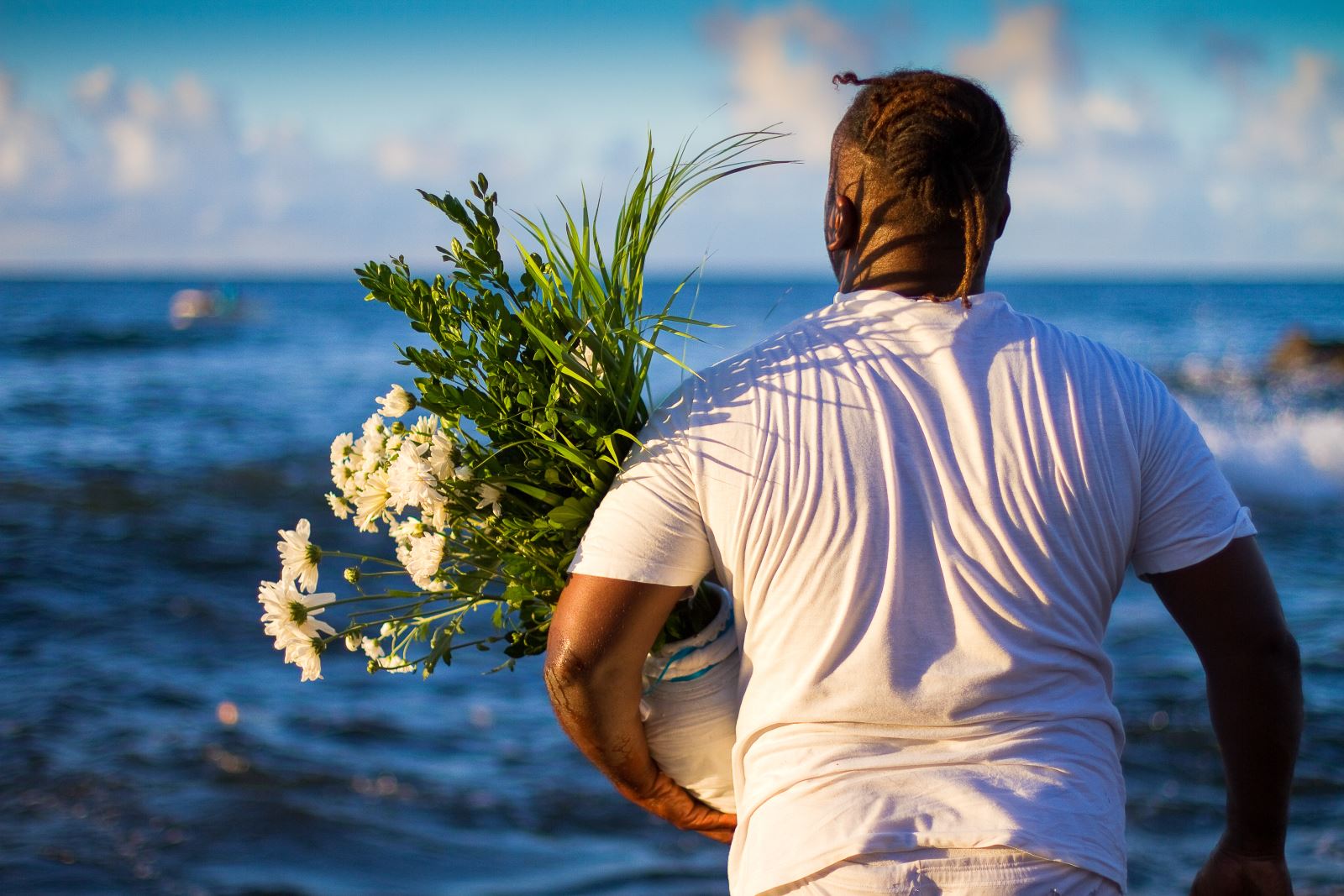Origins of popular culture and religiosity
The social and cultural environment of Salvador, cosmopolitan city since its founding today leads us to a strong religiosity that has developed here since the arrival of European foreign to the land of the Tupinambá Indians.
The Catholic religion of the settlers mingled, with the passage of time, with indigenous beliefs and religion of the enslaved black Africans who arrived here.
Traditional customs city confirms this statement:

Although according to the latest census the followers of African-based religion, Candomble, they were a small minority, the vast majority of Bahia wears white colors in the religious festivals of Catholicism and also on Fridays, day Hopefully, the largest Orixá .
The Roman Catholic beliefs, their ethics and their parties have the pace and tone of everyday life in Brazil in its colonial and imperial periods. Processions and religious festivals, older urban city activities, served to affirm the immense temporal and religious power of the Catholic Church and gathered the entire population regardless of social status or skin color.
The popular songbook says Salvador had 356 Catholic churches. One for each day of the year. In fact, today there are many: according to the Archdiocese of San Salvador, 372.
There was no ingenuity own chapel and chaplain particular. Education was long the monopoly of the Jesuit priests. Even the birth of a city usually made up from the construction of a chapel and the adoption of a saint or patron saint's day, which usually the city received the own clergy name.The wisely supported the realization of Candomblé parties.
The variety of churches, temples, terraces and the diversity of beliefs Salvador conferred city status marked by religiosity.
There are also Maronite Catholic church, synagogues, Presbyterian churches, mosques and other temples, living in harmony.
Candomblé, religion of African origin, Religion of the Orishas, was settled by African slaves brought to Brazil legally, between 1549 and 1850, continuing, however, until 1888, when slavery was abolished. Candomblé had its real structure, in the late seventeenth century and early nineteenth century, structuring maintained until today by traditional Terreiros.
So an ancient religion in the city, also practiced often by people who call themselves Catholic.
Initially restricted to the slaves for a long time, their practice was banned by the Catholic Church and persecuted by the police of numerous governments.
Candomblé is often confused with Umbanda and Macumba and is considered one soul religion, namely that worships the soul (anima) of Nature, represented by their kings and gods.
In the city of Salvador, there are 2,230 registered religious communities in Bahia Federation of Afro-Brazilian Cults.
Blacks brought from Angola and Congo were the first slaves to arrive in Bahia.
Then they came also from the Gulf of Benin, a region known by the sad name of the Slave Coast. Were the regions inhabited by Dahomeanos (the Jeje) and the Yoruba, mostly from Ketu nation (the Nagôs).
The Jeje and Nagôs and their rituals of worship to the gods seem to have served as a model for ethnic groups already installed in Bahia.
Represented in Brazil by Candomblé Ketu, have religion as a central element of their lives. Despite all the problems, "It is God who is in control during birth, life and death."
The Nago-Yoruba or established a rich culture, especially religious, on the grounds of the Bay of All Saints.
The enslaved blacks had their own religion, Candomblé; own music, foul, lundu; own dance, practiced in the samba; own cooking, which led to the Bahian cuisine, inventing various dishes based on palm oil and coconut milk (all too war flour of tupinambá and tapuia Indians), and desserts, developing what came from Portugal; own struggle, capoeira, and play, maculelê; own clothing, combining the already traditional African costumes to Portuguese fabrics and the "fashion" of the court, as well as a mixture of languages, merging with Yoruba Portuguese.
Not to let to practice their cults and rituals, various aspects of african-Brazilian religion were camouflaged by the black from the beginning. The Orishas - or gods worshiped entities in Candomblé - were hidden with names and images of Catholic saints with whom sought similarity to the features, history or representative elements. The festivities were held on the same days, among other things. Hence arose the religious syncretism.
The black slaves who came to Brazil came from across the African continent: the west coast, between Cape Verde and the Good Hope; the eastern coast of Mozambique; and even some parts of the interior. So had the most diverse stages of civilization.
.jpg)
The most important group introduced in Brazil was the Sudanese, that of Salvador markets spread throughout the Reconcavo. These black, the most notable were the Yoruba and Nago and gêgês, following up the mines.
But the greatest symbol of religiosity, religious syncretism and perhaps the greatest cultural icon of Salvador and Bahia is the "Bahia" traditional, recognized as cultural heritage of Brazil by the Historical and Artistic Institute (IPHAN) in 2005.
The image and clothing that brought the Sudanese Africa is miscegenation of black African and their religion with the Portuguese customs.
With their pompous costumes, torços (Turban, of Arab origin), "Shore cloths", coats (long, loose blouse), skirts (white or color printing) with lots of lace and starched petticoats, bracelets and necklaces (Yarn accounts) in the color of your deity, the traditional Bahian, holy, acarajé, the soteropolitana, is in all popular and religious festivals, washing the stairs of Catholic churches and also selling acarajé and other delicacies in the corners of the city.
The bracelets and necklaces are made with beads of different materials and colors and are very diverse and can be grouped by types according to the uses and meanings that have the cult of each African nation. Thus, accompany and mark the spiritual life of the faithful, from the very beginning of his religious initiation to their funerals.
Some of the necklaces of the known Orisha, also called tabs or strings of beads:
Eshu - black beads interspersed with red beads or gray beads; Ogun - green accounts or navy; Oxóssi - turquoise beads; Babalú-Ayé ### / Omolu - streaked white beads of black and brown; Oshun - gold beads or amber beads; Yemanja - translucent white beads or crystal beads; ### Oya / Iansa - brown beads or coral beads; Xango - red or brown beads interspersed with white beads; Hopefully - milky white beads.
Each day of the week is assigned to one or more Orixds. Below, we mention some of the best known, exemplifying, in some, its most striking features.

Monday - the first day, bowing to the "first" is also known as Eshu. The most human of Orisha, lord of the principle and transformation. Energy Eshu is what moves the world. We could say, the Orisha of dialectics ...
It is the essence of duality: it has the capacity to love and hate, unite and separate, promote peace and war, as well as man.
To be peace and tranquility among men, it is necessary to feed him first.
He is the owner of all warm and living things, starting with the fire (he shares with Shango and Oya) by blood, by palm oil, pepper and drinks.
Tuesday - day dedicated to OGUM, fearsome warrior, violent and ruthless. But there is no more dedicated protector, knowing protect his children and not let them padeçam. It is the Orisha of progress, advancement and technology.
Ogun does not tolerate lies. He owns the knife with which to make the sacrifices to the Orishas.
Wednesday - worships up the couple's Palm - Shango and Oya, also known as Iansã.
Fire and wind, thunder and lightning, one does not exist without the other. So it is with Shango and Oya. Nothing is a offers, without the provision another.
XANGO - Lord of fire and thunder.
King absolute, unbeatable and strong has the power your pleasure. He commands the powerful in his kingdom and the kingdom of neighbors. Exerts its rightful power not by force but by his uprightness and honesty, his ability to command and his keen sense of justice. It is also considered the Orisha of justice.
Their greeting is: KAWO kabiyèsílé! - Come see the King down on the earth! Or Save to Your Majesty on earth!
Oya - Iansã - Lady of lightning storms and winds.
In Acará the parties, Oya carries on his head a pan, usually copper, with its favorite food, known as acarajé, which is offered to all present, as she delights in their dances. (They say the best acarajés are made by Iansa's daughters).
Thursday - Ode - Oxóssi - is the hunter god, lord of forests and of all beings that inhabit it. Orisha of Oxóssi plenty protects hunters and animals (hunting), as both are in the same space beings: the forest.
Without reason, does not allow the killing of animals, mainly cattle, sacred animal to Oxóssi. "Those who kill what can not eat, do not you wait" and says the singer Geronimo, referring to this feeling of Ode, the hunter.
Friday - is the day to wear white in honor of OXALÁ. Be it the old Oxalufã that bears his opaxorô (symbolic stick), is Oxaguiã, your young warrior manifestation of Oxalá.
OXALÁ is the great symbol of synthesis of all backgrounds. Is all, creator of all beings, absolute master of all existence, of life and death.
In Bahia's religious syncretism is Our Lord of Bonfim, the eponymous church, protector of all Bahia. Represents the whole, the only Orixá that as Exú resides in all human beings. Its element is air, the essence of life. He is the father of a lifetime erring children and children who find the father who forgives because he loves.
Saturday is dedicated to all Iyabás: Iyemanjá, Oshun, Nana, Oba, Ewa.

IYEMANJÁ - is the queen of all waters in the world. Rivers, lakes, seas and oceans. Although revered in Brazil as Orisha of salt water, his name means "the river that flows into the sea."
It is the great mother of all the children, the mother and the mirror of the world, reflecting all the differences. Yemanja born of the stars, the clouds and the Orishas.
OXUM - Lady of fresh water and waterfalls. Lady Gold and wealth. Lady of beauty and love. African Venus. Mother and protector of children, is also the ruler of fertility. The waters of the womb in pregnancy, are Oshun waters.
NANA - old Iya (Lady, mother) goddess of mysteries. It dates back to the creation of the world. The mud of the marshes where they live is the foundation of Nana. It is the old mother par excellence. It is the beginning, because it is the clay and the clay was made a living. Syncretized with Ms. Sant'ana.
OBA - warrior in its essence. Woman fighting and claim their rights. Patron goddess of female power. Lady of the raging waters of rivers. Oba was one of Shango's wife, along with Oshun and Oya.
IYEWA - protector of virgins and of all that is untapped. Mastered clairvoyance. Lady of the night sky, cosmos queen. Iyewa is in the most hidden places where man can not reach. Represented by the white band Rainbow, the white rays of the sun, the snow, the white blood leaves.
Some of the most important popular parties of religious syncretism in Salvador
Culinary
Bahian food, "oil", are mostly "holy food" - food prepared in the religious festivals of candomblés for each Orisha. The Oil and Palm Oil is extracted from the fruit of the palm "palm oil".
Brought to Brazil during slavery, palm oil has become part of the typical cuisine of Salvador and the entire Bahia. Used in various recipes, palm oil is present acarajé the crumbs.
And in its original form, some variations are always welcome. Among them, the crumbly, made with butter or palm is a great accompaniment of Bahian cuisine.

